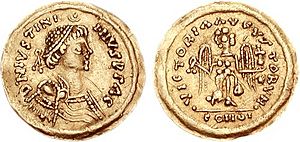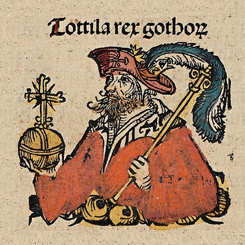Totila facts for kids
Quick facts for kids Totila |
|
|---|---|

A gold tremissis in the name of Justinian I, minted by Totila.
|
|
| King of the Ostrogoths | |
| Reign | 541–552 |
| Coronation | 541 |
| Predecessor | Eraric |
| Successor | Teia |
| Died | 1 July 552 Taginae, Italy |
| Religion | Arianism |
Totila, whose real name was Baduila, was a powerful king of the Ostrogoths. He ruled from 541 to 552 AD. He was a very skilled leader in both military and political matters.
Totila managed to turn the tide of the Gothic War. By 543, he had won back almost all the lands in Italy that the Eastern Roman Empire had taken from his kingdom in 540. He was related to Theudis, a king of the Visigoths.
Ostrogothic nobles chose Totila as their king in 541. This happened after their previous king, Witigis, was taken prisoner to Constantinople. Totila was a great leader. He gained the support of ordinary people by freeing slaves and giving land to farmers.
Contents
Totila's Early Life and Rise to Power
Totila's real name was Baduila, which can be seen on the coins he made. "Totila" was a nickname given to him by the Byzantine historian Procopius. Procopius wrote important stories about Totila during the Gothic War.
Totila was born in Treviso. He was related to Theudis, who was a king of the Visigoths. Totila became king of the Ostrogoths in 541. This happened after his uncle, Ildibad, was killed. Totila then helped remove Ildibad's short-term successor, his cousin Eraric.
Historians say Totila came from an important Gothic family. This family sometimes even challenged the famous Amal dynasty of Theodoric the Great.
Important Victories and Strategies
Winning Battles in Italy
After Totila became king, the Byzantines thought he wanted war. So, they sent a large army of 12,000 men to Verona. At Verona, some Roman soldiers got into the city. But the Goths quickly closed the gates, and the Romans had to escape.
The Roman army then went to Faenza. Totila met them there with 5,000 of his men in 542 AD. He defeated them in the Battle of Faventia. His archers surprised the Romans from behind. The Goths won many prisoners and battle flags.
After this, Totila defeated the Romans near Florence. He then captured Naples in 543. By fighting on land and sea, he took back most of the lost territory.
Totila's Clever Plans
Totila's plan was to move quickly and control the countryside. He left the Byzantine forces stuck in well-defended cities, especially the ports. When cities surrendered to him, he would tear down their walls, like at Beneventum.
Totila was known for being fast and merciful. He did not plunder the countryside like other invaders. Instead, he collected taxes and rents. This helped him get the money he needed without destroying the towns he captured. He also welcomed slaves into his army.
Taking Rome and Sicily
The Siege of Rome
In 544, Emperor Justinian I sent his general Belisarius back to Italy. Belisarius was supposed to stop Totila. But Belisarius did not have much money or many troops.
By the end of 545, Totila was preparing to starve Rome into surrender. He also made plans to stop Belisarius, who was trying to help the city. In December 545, Totila began to besiege Rome. A year later, he entered and plundered the city. He even prayed at St. Peter's Basilica.
Totila first planned to destroy Rome. But Belisarius convinced him not to, saying it would ruin his reputation forever. So, Totila left the city empty for about 40 days.
Rome Changes Hands
In April 546, Belisarius took Rome back. Totila tried to recapture it but failed. However, by 549, Totila's army had taken Rome again. He then went on to conquer all of Italy and Sicily. By the end of 550, Totila had taken back almost everything except Ravenna and four coastal towns.
Emperor Justinian then sent a new general named Narses in 551. Narses had a large army of 35,000 soldiers from different groups. They marched around the Adriatic Sea to approach Ravenna from the north.
Totila's Final Battle and Death
Totila then conquered and plundered Sicily. After that, he took Corsica and Sardinia. He also sent his fleet to attack the coasts of Greece.
In 551, Justinian's navy defeated Totila's fleet. Then, Narses led his army to challenge Totila. They met at the Battle of Taginae in the summer of 552. This was a very important battle. The Gothic army was defeated, and Totila was badly wounded. He died on July 1, 552.
Totila was followed by his relative Teia. Teia also died in battle a few months later at the Battle of Mons Lactarius. These defeats marked the end of the Ostrogothic Kingdom in Italy.
What Happened Next
The war officially ended in 554. Justinian then made new laws for Italy. He said that all laws made by Totila were invalid. The country was very damaged by the long war. Rome itself had been attacked and captured many times.
In 568, just three years after Justinian died, most of Italy was conquered by the Lombards. The Lombards absorbed the remaining Ostrogothic people.
See also
 In Spanish: Totila para niños
In Spanish: Totila para niños




